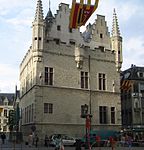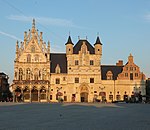Spanish Fury at Mechelen
1572 in the Habsburg NetherlandsBattles involving the Spanish NetherlandsBattles of the Eighty Years' WarConflicts in 1572Eighty Years' War (1566–1609) ... and 4 more
History of MechelenLooting in EuropeMassacres committed by SpainMassacres in Belgium

The Spanish Fury at Mechelen (Dutch: Spaanse Furie in Mechelen) was an event in the Eighty Years' War on October 2, 1572 in which the city of Mechelen was conquered by the Spanish army and brutally sacked.
Excerpt from the Wikipedia article Spanish Fury at Mechelen (License: CC BY-SA 3.0, Authors, Images).Spanish Fury at Mechelen
Geerdegem-Schonenberg,
Geographical coordinates (GPS) Address Nearby Places Show on map
Geographical coordinates (GPS)
| Latitude | Longitude |
|---|---|
| N 51.0167 ° | E 4.4667 ° |
Address
Geerdegem-Schonenberg 18
2800 (Mechelen)
Antwerp, Belgium
Open on Google Maps










